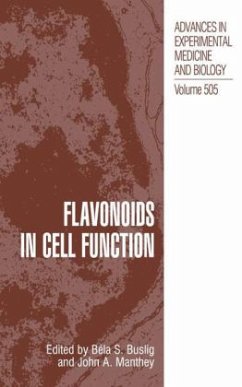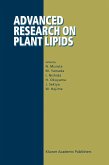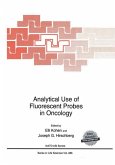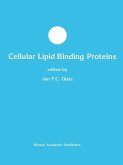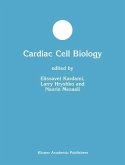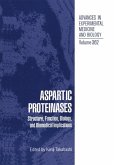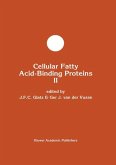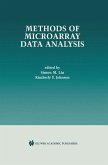B‚la Buslig / John Manthey (Hgg.)
Flavonoids in Cell Function
Herausgeber: Buslig, Béla, Manthey, John
B‚la Buslig / John Manthey (Hgg.)
Flavonoids in Cell Function
Herausgeber: Buslig, Béla, Manthey, John
- Gebundenes Buch
- Merkliste
- Auf die Merkliste
- Bewerten Bewerten
- Teilen
- Produkt teilen
- Produkterinnerung
- Produkterinnerung
This volume is based on presentations made at the symposium Flavonoids in Cell Function, held during the 219th National Meeting of the American Chemical Society in San Francisco, California on March 29-30, 2000. The papers cover a range of topics discussing various approaches to flavonoid study, starting at plant-microbe communication through analytical methods to medicinal and systemic ramifications of these compounds.
Andere Kunden interessierten sich auch für
![Advanced Research on Plant Lipids Advanced Research on Plant Lipids]() N. Murata / M. Yamada / I. Nishida / H. Okuyama / Jiro Sekiya / W. Hajime (Hgg.)Advanced Research on Plant Lipids202,99 €
N. Murata / M. Yamada / I. Nishida / H. Okuyama / Jiro Sekiya / W. Hajime (Hgg.)Advanced Research on Plant Lipids202,99 €![Analytical Use of Fluorescent Probes in Oncology Analytical Use of Fluorescent Probes in Oncology]() Elli Kohen / Joseph G. Hirschberg (Hgg.)Analytical Use of Fluorescent Probes in Oncology153,99 €
Elli Kohen / Joseph G. Hirschberg (Hgg.)Analytical Use of Fluorescent Probes in Oncology153,99 €![Cellular Lipid Binding Proteins Cellular Lipid Binding Proteins]() GlatzCellular Lipid Binding Proteins115,99 €
GlatzCellular Lipid Binding Proteins115,99 €![Cardiac Cell Biology Cardiac Cell Biology]() Elissavet Kardami / Larry Hryshko / Nasrin Mesaeli (Hgg.)Cardiac Cell Biology115,99 €
Elissavet Kardami / Larry Hryshko / Nasrin Mesaeli (Hgg.)Cardiac Cell Biology115,99 €![Aspartic Proteinases Aspartic Proteinases]() Kenji Takahashi (ed.)Aspartic Proteinases153,99 €
Kenji Takahashi (ed.)Aspartic Proteinases153,99 €![Cellular Fatty Acid-Binding Proteins II Cellular Fatty Acid-Binding Proteins II]() GlatzCellular Fatty Acid-Binding Proteins II153,99 €
GlatzCellular Fatty Acid-Binding Proteins II153,99 €![Methods of Microarray Data Analysis Methods of Microarray Data Analysis]() Simon M. Lin / Kimberly F. Johnson (eds.)Methods of Microarray Data Analysis77,99 €
Simon M. Lin / Kimberly F. Johnson (eds.)Methods of Microarray Data Analysis77,99 €-
-
-
This volume is based on presentations made at the symposium Flavonoids in Cell Function, held during the 219th National Meeting of the American Chemical Society in San Francisco, California on March 29-30, 2000. The papers cover a range of topics discussing various approaches to flavonoid study, starting at plant-microbe communication through analytical methods to medicinal and systemic ramifications of these compounds.
Produktdetails
- Produktdetails
- Advances in Experimental Medicine and Biology Vol.505
- Verlag: Springer, Berlin
- 2002
- Seitenzahl: 224
- Erscheinungstermin: 30. April 2002
- Englisch
- Abmessung: 241mm x 160mm x 19mm
- Gewicht: 674g
- ISBN-13: 9780306472541
- ISBN-10: 0306472546
- Artikelnr.: 21746895
- Herstellerkennzeichnung
- Springer-Verlag GmbH
- Tiergartenstr. 17
- 69121 Heidelberg
- ProductSafety@springernature.com
- Advances in Experimental Medicine and Biology Vol.505
- Verlag: Springer, Berlin
- 2002
- Seitenzahl: 224
- Erscheinungstermin: 30. April 2002
- Englisch
- Abmessung: 241mm x 160mm x 19mm
- Gewicht: 674g
- ISBN-13: 9780306472541
- ISBN-10: 0306472546
- Artikelnr.: 21746895
- Herstellerkennzeichnung
- Springer-Verlag GmbH
- Tiergartenstr. 17
- 69121 Heidelberg
- ProductSafety@springernature.com
1. Flavonoids in cell function; J.A. Manthey, et al.
2. Host recognition by pathogenic fungi through plant flavonoids; D. Straney, et al.
3. Signalling in arbuscular mycorrhiza: Facts and hypotheses; H. Vierheilig, Y. Piché.
4. The use of a photoactivatable kaempferol analogue to probe the role of flavonol 3- O -galactosyltransferase in pollen germination; L.P. Taylor, K.D. Miller.
5. Flavonoids: signal molecules in plant development; Ho-Hyung Woo, et al.
6. Modern analytical techniques for flavonoid determination; M.A. Berhow.
7. HPLC-mass spectrometry of isoflavonoids in soy and the American groundnut, Apios americana ; S. Barnes, et al.
8. History as a tool in identifying "new" old drugs; J.M. Riddle.
9. Potential health benefits from the flavonoids in grape products on vascular disease; J.D. Folts.
10. Polyphenol antioxidants in citrus juices: in vitro and in vivo studies relevant to heart disease; J.A. Vinson, et al.
11. Inhibition of colonic aberrant crypt formation by the dietary flavonoids (+)-catechin and hesperidin; A.A. Franke, et al.
12. The citrus methoxyflavone tangeretin affects human cell-cell interactions; M.E. Bracke, et al.
13. Xanthine oxidase and xanthine dehydrogenase inhibition by the procyanidin-rich french maritime pine bark extract, Pycnogenol®: A protein binding effect; H. Moini, et al. 1
4. Human 17beta-hydroxysteroid dehydrogenase type 5 is inhibited by dietary flavonoids; A. Krazeisen, et al.
15. Interactions of flavones and other phytochemicals with adenosine receptors; K.A. Jacobson, et al.
16. Regulation of lipoprotein metabolism in HepG2 cells by citrus flavonoids; E.M. Kurowska, J.A. Manthey.
17. Anti-inflammatory actions of a micronized, purified flavonoid fraction in ischemia/reperfusion; R.J. Korthuis, D.C. Gute.
18. Flavonoids and gene expression in mammalian cells; Shiu-Ming Kuo.
Index.
2. Host recognition by pathogenic fungi through plant flavonoids; D. Straney, et al.
3. Signalling in arbuscular mycorrhiza: Facts and hypotheses; H. Vierheilig, Y. Piché.
4. The use of a photoactivatable kaempferol analogue to probe the role of flavonol 3- O -galactosyltransferase in pollen germination; L.P. Taylor, K.D. Miller.
5. Flavonoids: signal molecules in plant development; Ho-Hyung Woo, et al.
6. Modern analytical techniques for flavonoid determination; M.A. Berhow.
7. HPLC-mass spectrometry of isoflavonoids in soy and the American groundnut, Apios americana ; S. Barnes, et al.
8. History as a tool in identifying "new" old drugs; J.M. Riddle.
9. Potential health benefits from the flavonoids in grape products on vascular disease; J.D. Folts.
10. Polyphenol antioxidants in citrus juices: in vitro and in vivo studies relevant to heart disease; J.A. Vinson, et al.
11. Inhibition of colonic aberrant crypt formation by the dietary flavonoids (+)-catechin and hesperidin; A.A. Franke, et al.
12. The citrus methoxyflavone tangeretin affects human cell-cell interactions; M.E. Bracke, et al.
13. Xanthine oxidase and xanthine dehydrogenase inhibition by the procyanidin-rich french maritime pine bark extract, Pycnogenol®: A protein binding effect; H. Moini, et al. 1
4. Human 17beta-hydroxysteroid dehydrogenase type 5 is inhibited by dietary flavonoids; A. Krazeisen, et al.
15. Interactions of flavones and other phytochemicals with adenosine receptors; K.A. Jacobson, et al.
16. Regulation of lipoprotein metabolism in HepG2 cells by citrus flavonoids; E.M. Kurowska, J.A. Manthey.
17. Anti-inflammatory actions of a micronized, purified flavonoid fraction in ischemia/reperfusion; R.J. Korthuis, D.C. Gute.
18. Flavonoids and gene expression in mammalian cells; Shiu-Ming Kuo.
Index.
1. Flavonoids in cell function; J.A. Manthey, et al.
2. Host recognition by pathogenic fungi through plant flavonoids; D. Straney, et al.
3. Signalling in arbuscular mycorrhiza: Facts and hypotheses; H. Vierheilig, Y. Piché.
4. The use of a photoactivatable kaempferol analogue to probe the role of flavonol 3- O -galactosyltransferase in pollen germination; L.P. Taylor, K.D. Miller.
5. Flavonoids: signal molecules in plant development; Ho-Hyung Woo, et al.
6. Modern analytical techniques for flavonoid determination; M.A. Berhow.
7. HPLC-mass spectrometry of isoflavonoids in soy and the American groundnut, Apios americana ; S. Barnes, et al.
8. History as a tool in identifying "new" old drugs; J.M. Riddle.
9. Potential health benefits from the flavonoids in grape products on vascular disease; J.D. Folts.
10. Polyphenol antioxidants in citrus juices: in vitro and in vivo studies relevant to heart disease; J.A. Vinson, et al.
11. Inhibition of colonic aberrant crypt formation by the dietary flavonoids (+)-catechin and hesperidin; A.A. Franke, et al.
12. The citrus methoxyflavone tangeretin affects human cell-cell interactions; M.E. Bracke, et al.
13. Xanthine oxidase and xanthine dehydrogenase inhibition by the procyanidin-rich french maritime pine bark extract, Pycnogenol®: A protein binding effect; H. Moini, et al. 1
4. Human 17beta-hydroxysteroid dehydrogenase type 5 is inhibited by dietary flavonoids; A. Krazeisen, et al.
15. Interactions of flavones and other phytochemicals with adenosine receptors; K.A. Jacobson, et al.
16. Regulation of lipoprotein metabolism in HepG2 cells by citrus flavonoids; E.M. Kurowska, J.A. Manthey.
17. Anti-inflammatory actions of a micronized, purified flavonoid fraction in ischemia/reperfusion; R.J. Korthuis, D.C. Gute.
18. Flavonoids and gene expression in mammalian cells; Shiu-Ming Kuo.
Index.
2. Host recognition by pathogenic fungi through plant flavonoids; D. Straney, et al.
3. Signalling in arbuscular mycorrhiza: Facts and hypotheses; H. Vierheilig, Y. Piché.
4. The use of a photoactivatable kaempferol analogue to probe the role of flavonol 3- O -galactosyltransferase in pollen germination; L.P. Taylor, K.D. Miller.
5. Flavonoids: signal molecules in plant development; Ho-Hyung Woo, et al.
6. Modern analytical techniques for flavonoid determination; M.A. Berhow.
7. HPLC-mass spectrometry of isoflavonoids in soy and the American groundnut, Apios americana ; S. Barnes, et al.
8. History as a tool in identifying "new" old drugs; J.M. Riddle.
9. Potential health benefits from the flavonoids in grape products on vascular disease; J.D. Folts.
10. Polyphenol antioxidants in citrus juices: in vitro and in vivo studies relevant to heart disease; J.A. Vinson, et al.
11. Inhibition of colonic aberrant crypt formation by the dietary flavonoids (+)-catechin and hesperidin; A.A. Franke, et al.
12. The citrus methoxyflavone tangeretin affects human cell-cell interactions; M.E. Bracke, et al.
13. Xanthine oxidase and xanthine dehydrogenase inhibition by the procyanidin-rich french maritime pine bark extract, Pycnogenol®: A protein binding effect; H. Moini, et al. 1
4. Human 17beta-hydroxysteroid dehydrogenase type 5 is inhibited by dietary flavonoids; A. Krazeisen, et al.
15. Interactions of flavones and other phytochemicals with adenosine receptors; K.A. Jacobson, et al.
16. Regulation of lipoprotein metabolism in HepG2 cells by citrus flavonoids; E.M. Kurowska, J.A. Manthey.
17. Anti-inflammatory actions of a micronized, purified flavonoid fraction in ischemia/reperfusion; R.J. Korthuis, D.C. Gute.
18. Flavonoids and gene expression in mammalian cells; Shiu-Ming Kuo.
Index.

